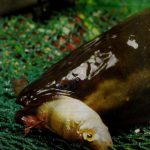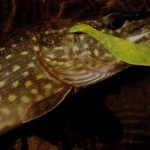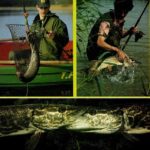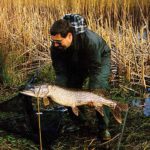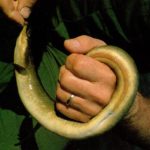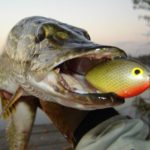Wielu wędkarzy łowi na filety z ryb dopiero wtedy, gdy mają kłopoty ze zdobyciem małych martwych rybek lub żywca. W rzeczywistości filety z ryb są jedną z najbardziej łownych i uniwersalnych przynęt. Należy je tylko odpowiednio wyciąć.
W przeciwieństwie do całych martwych ryb, ulubionej przynęty tak wielu wędkarzy łowiących drapieżniki, filety z ryb nie cieszą się zbyt dużą popularnością. Dlaczego? Ponieważ jest to nienaturalne, że martwa ryba jest podzielona na kawałki. Ach tak? A co się dzieje, gdy rak zabiera się do jedzenia o wiele za dużej jak na swoje rozmiary ryby leżącej na dnie? Co dzieje się z leszczem, który dostanie się w śrubę silnika łodzi motorowej lub statku? Co pozostaje na brzegu lub w wodzie po uczcie norki, wydry lub tchórza? Co dzieje się z węgorzami próbującymi przecisnąć się przez pracujące turbiny? Co wylatuje za burtę, gdy rybacy patroszą ryby?
To tyle na temat rzekomej nienaturalności filetów z ryb jako przynęt. Filety z ryb można wycinać na wiele różnych sposobów, można też nadawać im dowolne kształty. Wędkarz nie powinien jednak bez zastanowienia kroić martwej ryby na kawałki. Musi najpierw się zastanowić, w jaki sposób chce łowić na filety oraz na jakie ryby się nastawia. Przykładowo w delcie Wołgi do łowienia sumów używa się dużych filetów z boleni. Z drugiej strony, na maleńkie fileciki biorą także ryby spokojnego żeru. Na małą kostkę z rybiego mięsa łowiłem już duże liny, leszcze, krąpie, a nawet wzdręgi. Filety z ryb są nie tylko skuteczną, ale i bardzo uniwersalną przynętą. Aktywnie wędkujący koledzy mogą nimi spinningować (systemik spinningowy, główka twistera z filetem, podciąganie przynęty po dnie), natomiast wędkarze lubiący nasiadówki łowią na nie zazwyczaj metodą gruntową. Ze względu na to, że filety z ryb szybko się „wypłukują” w wodzie, a tym samym stają mniej atrakcyjne, sposobem godnym polecenia jest wcześniejsze potraktowanie ich jakimś środkiem wabiącym. Nie ma w tym nic trudnego – wytnijcie z martwej ryby filety, a następnie „wykąpcie” je przez pół godziny w wybranym według własnego gustu środku smakowo-zapachowym. Nie obawiajcie się, że Wasza przynęta będzie miała zbyt intensywny zapach! Chociaż zawsze zaleca się dozowanie środków smakowo-zapachowych kroplami, tym razem śmiało może to być dłuższa kąpiel.
Na moje „marynowane” w sandaczowym atraktorze filety złowiłem już wiele ładnych sandaczy i jeszcze ani razu nie zauważyłem, aby serwowana im „bomba zapachowa” działała na nie odstraszająco. Prawdopodobnie wynika to też z faktu, że najchętniej łowię w wodzie płynącej.
Woda szybko wypłukuje znaczną część olejków zapachowych z przynęty. Smuga zapachowa spływa z prądem wody i intryguje, a bardzo często także wabi drapieżniki w górę rzeki.
Po kąpieli w atraktorze filet z ryby zachowuje atrakcyjny zapach prawie przez całą noc.
Rysunki w ramkach pokazują najlepsze sposoby Zbrojenia filetów.
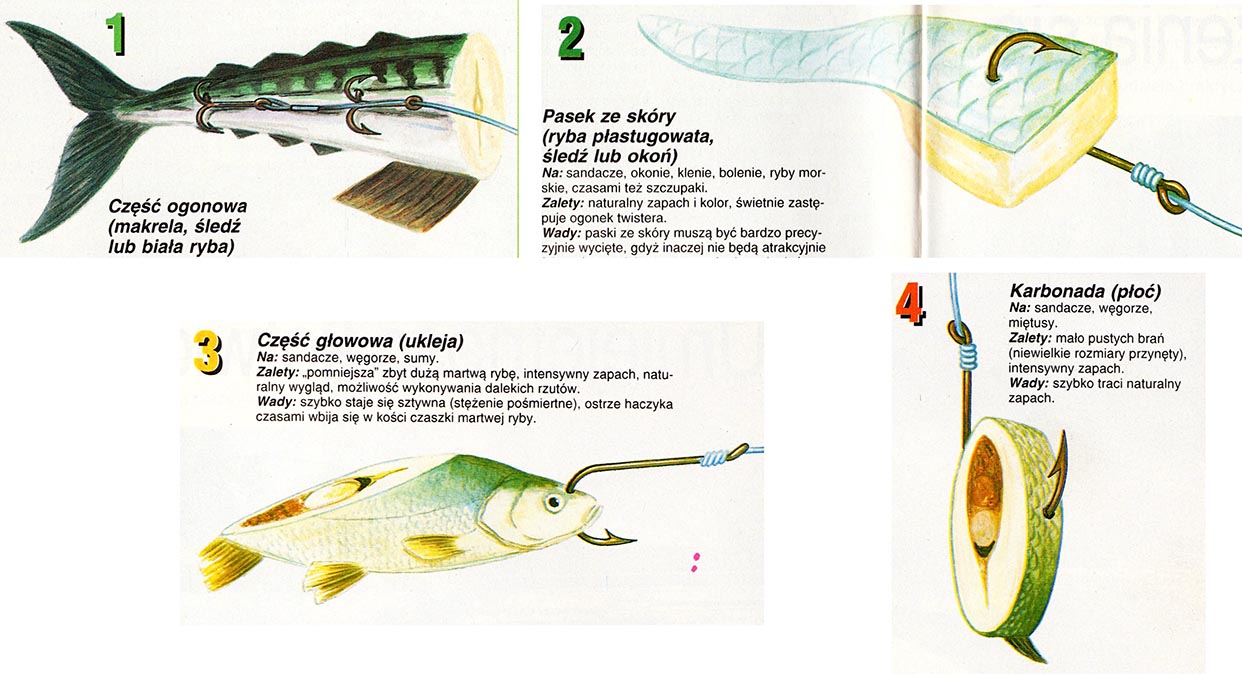 1. Część ogonowa (makrela, śledź lub biała ryba)
1. Część ogonowa (makrela, śledź lub biała ryba)
Na: sandacze, węgorze, czasami też szczupaki.
Zalety: „pomniejszenie” zbyt dużej martwej ryby, naturalny i atrakcyjny wygląd dzięki obecności płetwy ogonowej.
Wady: szybko staje się sztywna (stężenie pośmiertne), słabe rozchodzenie się zapachu, kotwiczki systemiku nacinają czasami mięśnie ogonowe.
2. Pasek ze skóry (ryba płastugowata, śledź lub okoń)
Na: sandacze, okonie, klenie, bolenie, ryby morskie, czasami też szczupaki.
Zalety: naturalny zapach i kolor, świetnie zastępuje ogonek twistera.
Wady: paski ze skóry muszą być bardzo precyzyjnie wycięte, gdyż inaczej nie będą atrakcyjnie falować w wodzie, często trzeba je zmieniać.
3. Część głowowa (ukleja)
Na: sandacze, węgorze, sumy.
Zalety: „pomniejsza” zbyt dużą martwą rybę, intensywny zapach, naturalny wygląd, możliwość wykonywania dalekich rzutów.
Wady: szybko staje się sztywna (stężenie pośmiertne), ostrze haczyka czasami wbija się w kości czaszki martwej ryby.
4. Karbonada (płoć)
Na: sandacze, węgorze, miętusy.
Zalety: mało pustych brań (niewielkie rozmiary przynęty), intensywny zapach.
Wady: szybko traci naturalny zapach.
 5. Zszyte powłoki brzuszne (biała ryba, okoń)
5. Zszyte powłoki brzuszne (biała ryba, okoń)
Na: szczupaki, sandacze, okonie, bolenie.
Zalety: dobra przynęta naturalna do systemików spinningowych.
Wady: przy wielu braniach szybko się rozrywa.
6. Kostka mięsa (biała ryba)
Na: okonie, węgorze, liny, krąpie, leszcze, jazie, brzany.
Zalety: intensywny zapach w wodzie, możliwość łowienia także ryb spokojnego żeru, prawie całkowity brak pustych brań (niewielkie rozmiary przynęty).
Wady: szybko traci zapach, miękka konsystencja (konieczność ciągłego zmieniania przynęty), często objadana przez raki.
7. Tradycyjny filet (biała ryba)
Na: sandacze, okonie, sumy, czasami tez węgorze.
Zalety: mato pustych brań sandaczy (niewielkie rozmiary przynęty), wewnętrzna strona filetu wydziela do wody atrakcyjny zapach, a jej postrzępiona powierzchnia dłużej zachowuje zapach ewentualnego atraktora.
Wady: szybko traci naturalny zapach, odkształca się na haczyku, nie pozwala na dalekie rzuty.
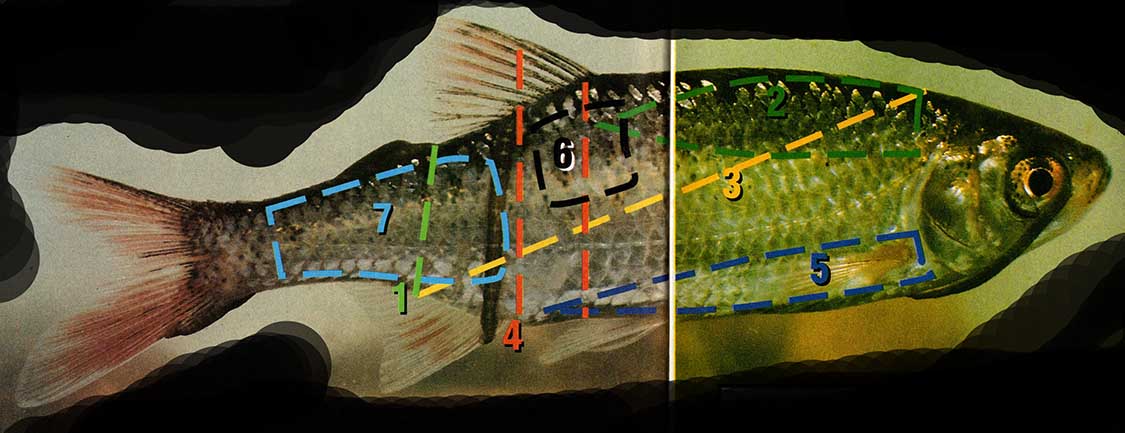 Wzorzec wycinania filetów (na przykład z wymiarowej płoci). Z jednej ryby można otrzymać różne przynęty (cyfry 1 – 7).
Wzorzec wycinania filetów (na przykład z wymiarowej płoci). Z jednej ryby można otrzymać różne przynęty (cyfry 1 – 7).

